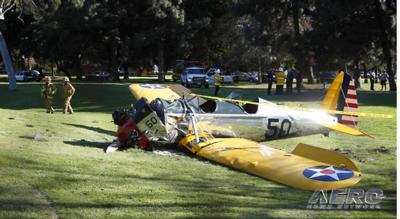Complete Loss Of Engine Power After Carburetor Main Metering Jet Became Unseated
The NTSB has released its probable cause report from the accident which injured actor Harrison Ford in March. The board says a mechanical failure led to the total loss of engine power in Ford's airplane.

According to the report, shortly after takeoff from the Santa Monica Municipal Airport (KSMO), Santa Monica, CA, the pilot advised the air traffic control tower controller that the engine had lost power, and the pilot requested an immediate return to the airport. The pilot initiated a left turn toward the airport; however, during the approach, he realized that the airplane was unable to reach the runway. Subsequently, the airplane struck the top of a tree and then impacted the ground in an open area of a golf course.
A postaccident examination of the airplane's engine revealed that the carburetor's main metering jet was unscrewed from its seat and rotated 90 degrees. The unseated jet would have allowed an increased fuel flow through the main metering orifice, producing an extremely rich fuel-to-air ratio, which would have resulted in the loss of engine power. It is likely that, over time, the jet gradually loosened from its seat, which allowed it to eventually rotate 90 degrees. No further mechanical failures or malfunctions were revealed that would have precluded normal operation.
A review of the airplane's maintenance records indicated that the carburetor was rebuilt during the airplane's restoration about 17 years before the accident. The carburetor maintenance instruction manual contained no pertinent instructions for the installation of the jet assemblies. Further, no maintenance entries in the engine logbook regarding carburetor maintenance were found. Had the carburetor maintenance instruction manual identified a means to ensure the security of the main metering jet, it is unlikely that the jet would have become unseated. There was no record of maintenance personnel inspecting the carburetor jets during the previous 17 years nor was there a requirement to do so.
The front and rear seats of the airplane were equipped with non-factory-installed shoulder harnesses. The pilot's shoulder harness was installed by mounting the end of the restraint to the lower portion of the seatback assembly, which was made of thin aluminum. No reinforcement material or doublers were installed at or around the attachment bolt hole in the seatback. The lack of reinforcement allowed the attachment bolt, washers, and stop nut to be pulled upward and through the seatback structure during the impact sequence, which resulted in the pilot's loss of shoulder harness restraint. It is likely that the improperly installed shoulder harness contributed to the severity of the pilot's injuries.
As a result of this investigation, the NTSB is working with the pilot community to inform them of the lessons learned from this accident: the security of the carburetor's main metering jet and the security of the shoulder harness are both critical aspects of aviation safety.
The NTSB determined the probable cause(s) of this accident to be a total loss of engine power during initial climb when the carburetor main metering jet became unseated, which led to an extremely rich fuel-to-air ratio. Contributing to the accident was the lack of adequate carburetor maintenance instructions. Contributing to the severity of the pilot's injuries was the improperly installed shoulder harness.
(Image from file)
 ANN's Daily Aero-Term (07.15.25): Charted Visual Flight Procedure Approach
ANN's Daily Aero-Term (07.15.25): Charted Visual Flight Procedure Approach Aero-News: Quote of the Day (07.15.25)
Aero-News: Quote of the Day (07.15.25) ANN's Daily Aero-Linx (07.15.25)
ANN's Daily Aero-Linx (07.15.25) NTSB Final Report: Kjelsrud Gary Kitfox
NTSB Final Report: Kjelsrud Gary Kitfox NTSB Prelim: Cessna A150L
NTSB Prelim: Cessna A150L



